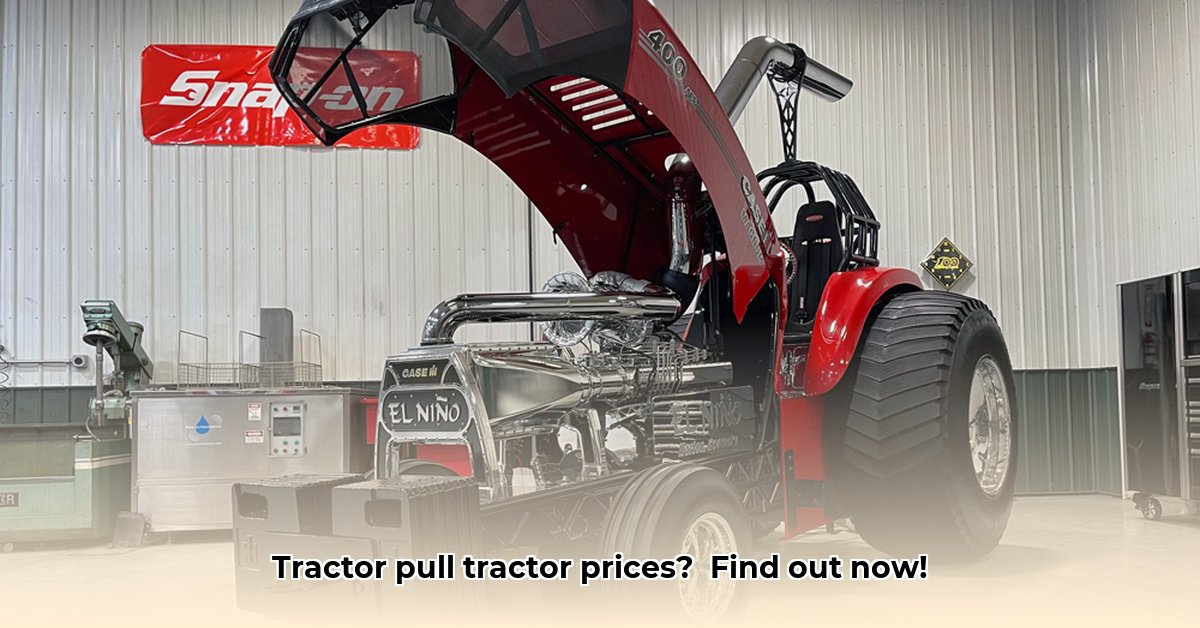
Understanding the Cost of Competitive Tractor Pulling
So, you're captivated by the thrill of tractor pulling? Before you unleash the roar of the engine, let's address the financial realities. The cost of competitive tractor pulling varies dramatically, ranging from a surprisingly affordable entry point to a significant investment that rivals the price of a luxury vehicle. This guide will dissect the factors influencing costs, provide insights into current market trends, and equip you with actionable steps to navigate this exciting yet expensive hobby. For a deeper dive into specific costs, check out this helpful resource: Tractor Pulling Costs.
Horsepower: The Foundation of Cost
The most significant cost driver is horsepower. More horsepower translates to greater pulling power and, consequently, a higher price. Think of it as the muscle behind the competition; a more powerful engine demands a more substantial upfront investment. A stock tractor will cost significantly less than a heavily modified competition machine. This is simply the price of raw power. What's a reasonable horsepower target for competitive pulling? A good starting point would be to research the minimum horsepower requirements for your chosen class, but be aware that even exceeding the minimum will require heavier investment.
Modifications: Fine-Tuning Your Machine
Most pulling tractors undergo extensive modifications to enhance their competitive edge. These alterations, ranging from engine tuning to complete chassis overhauls, significantly impact the overall cost. While minor adjustments are relatively inexpensive, substantial modifications, such as engine rebuilds with cutting-edge components, can easily add tens of thousands of dollars to the final price. Consider engine upgrades, transmission modifications, and chassis reinforcements. Each of these can impact the final price. How much will modifications cost? That depends on your ambition and the level of competitive success you aim for.
Brand and Reputation: The Premium Factor
The brand of your tractor plays a role in determining its cost. Established brands known for high-performance and reliability often command a premium price. This added cost reflects the reputation for quality, durability, and a proven track record of success. Are certain brands notably more expensive? Yes, some brands, due to their history of producing high-performance pulling tractors, command markedly higher prices than others. This premium reflects their reputation for quality and consistent performance.
Purchasing Strategies: New vs. Used
Choosing between a new or used tractor significantly impacts your budget. Used tractors offer cost savings but present the risk of unexpected repairs and the potential for difficulty in sourcing parts. New tractors eliminate this uncertainty but come with a substantially higher initial investment. Experts advise a thorough pre-purchase inspection, especially for used equipment, possibly even consulting a qualified mechanic. What's the wiser choice? The decision hinges on your budget and risk tolerance.
Competition Class: Rules and Costs
Tractor pulling encompasses various classes, each with its own set of rules and regulations. These regulations determine permissible modifications, thus directly affecting the type of tractor required and its associated costs. Higher classes generally demand more extensive and expensive modifications, leading to a steeper price tag. How do class rules influence the budget? The regulations significantly dictate which modifications are necessary and permissible; therefore, they impact the amount of investment required to become competitive within a specific class.
A Snapshot of Current Costs
While precise figures are elusive due to market fluctuations and diverse configurations, here's a broad overview of potential cost ranges in USD:
| Tractor Type | Estimated Cost Range (USD) |
|---|---|
| Used, Entry-Level | $20,000 - $50,000 |
| Modified, Mid-Range | $50,000 - $150,000 |
| High-Performance, New | $150,000 - $300,000+ |
Remember, these are mere estimates. Significant engine modifications alone can push the final price substantially higher.
Ongoing Costs: Beyond the Initial Purchase
Owning a pulling tractor involves substantial ongoing costs beyond the initial investment. These include regular maintenance, potential repairs, and the cost of specialized parts. Finding replacement parts for heavily modified tractors can be especially challenging and expensive. How substantial are these ongoing expenses? They can quickly add up and must be carefully factored into your long-term budget.
Future Trends: A Look Ahead
The tractor pulling landscape is ever-evolving. We anticipate increased specialization within competition classes, driving demand for even more complex and costly modifications. Similarly, growing interest in this sport could translate into higher production costs. What should we anticipate? Market trends indicate that tractor pulling will likely become even more specialized, with potentially ever-increasing costs.
Financing Your Pulling Tractor: A Strategic Approach
Securing funding for a competitive pulling tractor requires a well-defined financial strategy. Consider these options:
- Personal Savings: This requires long-term planning and significant savings.
- Loans: Explore secured or unsecured loans, carefully comparing interest rates.
- Sponsorships: Seek partnerships with agricultural businesses or related industries.
- Partnerships: Team up with other enthusiasts to share costs and expertise.
- Selling Existing Equipment: Generate funds through the sale of previously owned equipment.
- Crowdfunding: Utilize online platforms to leverage a wide network of potential contributors.
Prioritize modifications strategically, focusing on those yielding substantial performance gains without exceeding your budget. Remember: Consistent maintenance dramatically reduces the cost and hassle of unplanned repairs. Building a competitive machine is a long-term investment.